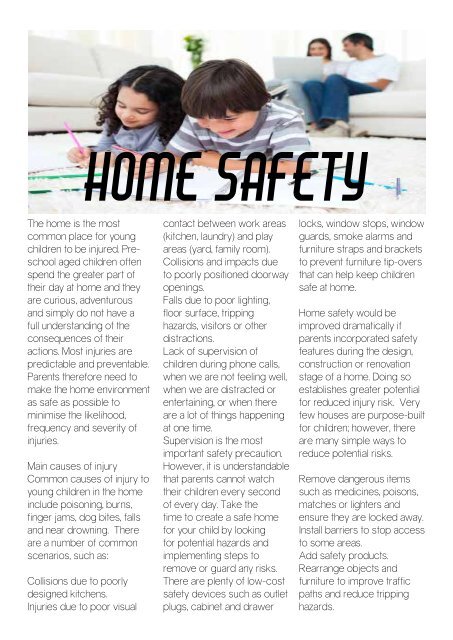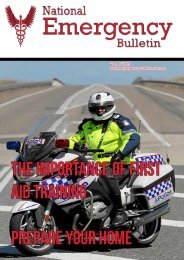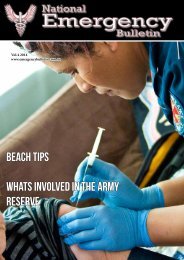Safe Kids Watch Vol 8 2015
You also want an ePaper? Increase the reach of your titles
YUMPU automatically turns print PDFs into web optimized ePapers that Google loves.
Home <strong>Safe</strong>ty<br />
The home is the most<br />
common place for young<br />
children to be injured. Preschool<br />
aged children often<br />
spend the greater part of<br />
their day at home and they<br />
are curious, adventurous<br />
and simply do not have a<br />
full understanding of the<br />
consequences of their<br />
actions. Most injuries are<br />
predictable and preventable.<br />
Parents therefore need to<br />
make the home environment<br />
as safe as possible to<br />
minimise the likelihood,<br />
frequency and severity of<br />
injuries.<br />
Main causes of injury<br />
Common causes of injury to<br />
young children in the home<br />
include poisoning, burns,<br />
finger jams, dog bites, falls<br />
and near drowning. There<br />
are a number of common<br />
scenarios, such as:<br />
Collisions due to poorly<br />
designed kitchens.<br />
Injuries due to poor visual<br />
contact between work areas<br />
(kitchen, laundry) and play<br />
areas (yard, family room).<br />
Collisions and impacts due<br />
to poorly positioned doorway<br />
openings.<br />
Falls due to poor lighting,<br />
floor surface, tripping<br />
hazards, visitors or other<br />
distractions.<br />
Lack of supervision of<br />
children during phone calls,<br />
when we are not feeling well,<br />
when we are distracted or<br />
entertaining, or when there<br />
are a lot of things happening<br />
at one time.<br />
Supervision is the most<br />
important safety precaution.<br />
However, it is understandable<br />
that parents cannot watch<br />
their children every second<br />
of every day. Take the<br />
time to create a safe home<br />
for your child by looking<br />
for potential hazards and<br />
implementing steps to<br />
remove or guard any risks.<br />
There are plenty of low-cost<br />
safety devices such as outlet<br />
plugs, cabinet and drawer<br />
locks, window stops, window<br />
guards, smoke alarms and<br />
furniture straps and brackets<br />
to prevent furniture tip-overs<br />
that can help keep children<br />
safe at home.<br />
Home safety would be<br />
improved dramatically if<br />
parents incorporated safety<br />
features during the design,<br />
construction or renovation<br />
stage of a home. Doing so<br />
establishes greater potential<br />
for reduced injury risk. Very<br />
few houses are purpose-built<br />
for children; however, there<br />
are many simple ways to<br />
reduce potential risks.<br />
Remove dangerous items<br />
such as medicines, poisons,<br />
matches or lighters and<br />
ensure they are locked away.<br />
Install barriers to stop access<br />
to some areas.<br />
Add safety products.<br />
Rearrange objects and<br />
furniture to improve traffic<br />
paths and reduce tripping<br />
hazards.





